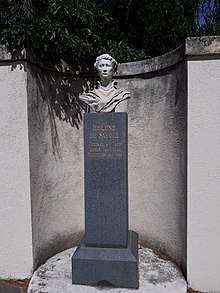Elena of Montenegro

Princess Elena of Montenegro (born January 8, 1873 in Cetinje , Montenegro , † November 28, 1952 in Montpellier , France ) was a member of the House of Petrović-Njegoš . By marriage she became Queen of Italy and Albania , Empress of Ethiopia and Duchess of Savoy .
Life
Elena was the sixth and youngest daughter of King Nikola I of Montenegro (1841-1921) and his wife Milena Vukotić (1847-1923). She grew up with her siblings in Cetinje. She was educated in the Russian boarding school Smolny Monastery under the protection of Tsarina Maria Feodorovna and studied politics and philosophy at the University of Saint Petersburg .
On October 24, 1896, Princess Elena of Montenegro married Crown Prince Viktor Emanuel, Prince of Naples (1869-1947), the only son of the first Italian King Umberto I and Princess Maria Margarethe Therese Johanna of Genoa in the Quirinal Palace in Rome . The marriage resulted in five children who married into various European royal houses.
Her husband was more of a bourgeois than a noble Savoy who had inherited the obligation to be king. He was undemanding and thrifty to the point of stinginess, stubborn and skeptical of people and events. Viktor Emanuel had complexes because of his small size (1.48 m) and his uncomfortable appearance. He instinctively held back and was unsure of all interpersonal contacts.
After the death of her father-in-law, King Umberto I, her husband ascended on August 11, 1900, when King Victor Emanuel III. the Italian throne. Through the colonial rule Elena became not only Queen of Italy, but later also Queen of Albania and Empress of Ethiopia.
In the Strait of Messina there was a severe earthquake on December 28, 1908, which almost completely destroyed the cities of Messina and Reggio Calabria, killing 70,000 people. Queen Elena helped by signing portrait photos of herself and putting them up for sale. The proceeds were used for the reconstruction. This earned the queen great popularity among the population.
During the First World War she was one of the voluntary nurses of the Red Cross and released the Villa Margherita as a hospital. She later studied medicine and received a doctorate to help further.
In 1946 her husband abdicated in favor of her son Umberto II and went into exile with his wife that same year . In Alexandria they found hospitality with King Farouk . Her husband died on December 28, 1947 in exile in Alexandria in what was then the Kingdom of Egypt . In 1950 ex-Queen Elena was diagnosed with cancer, on November 28, 1952, she died during the operation in Montpellier and, at her request, was buried in the city cemetery of Montpellier. In December 2017, her remains were transferred to the pilgrimage church of Vicoforte in Piedmont , where other family members of the House of Savoy are also buried.
The Rifugio Elena refuge is dedicated to her in the Aosta Valley .
progeny
- Yolanda Margherita Milena Elisabetta Romana Maria (1901–1986) ⚭ 1923 Giorgio Carlo Calvi, Count Bergolo (1887–1977)
- Mafalda Maria Elisabetta Anna Romana (1902–1944; in Buchenwald concentration camp ) ⚭ 1925 Prince Philip of Hesse (1896–1980)
- Umberto Nicola Tomaso Giovanni (1904–1983) ⚭ 1930 Princess Marie José of Belgium (1906–2001)
- Giovanna Elisabetta Antonia Romana Maria (1907–2000) ⚭ 1930 Tsar Boris III. of Bulgaria (1894–1943)
- Maria Francesca Anna Romana (1914–2001) ⚭ 1939 Prince Ludwig of Bourbon-Parma (1899–1967)
literature
- Alberto Lumbroso: Elena di Montenegro, Regina d'Italia , Florence (1935)
- Jean-Paul Gisserot: Généalogie des rois et des princes. Jean-Charles Volkmann Edit (1998)
Web links
Individual evidence
- ↑ Corriere.it of December 15, 2017 (Italian) accessed on December 17, 2017
| Predecessors | Office | Successors |
|---|---|---|
| Margaret of Italy | Queen of Italy 1900–1946 |
Marie José of Belgium |
| Menen II. | "Empress of Ethiopia" 1936–1941 |
Menen II. |
| Geraldine Apponyi | "Queen of Albania" 1939–1943 |
- |
| personal data | |
|---|---|
| SURNAME | Elena of Montenegro |
| ALTERNATIVE NAMES | Elena of Italy |
| BRIEF DESCRIPTION | Queen of Italy |
| DATE OF BIRTH | January 8, 1873 |
| PLACE OF BIRTH | Cetinje , Montenegro |
| DATE OF DEATH | November 28, 1952 |
| Place of death | Montpellier , France |

